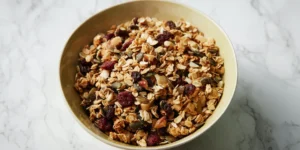Bread is a staple in many diets worldwide, offering a mix of essential nutrients, fibre, and convenience (I love sandwiches!). However, not all types of bread digest the same way for everyone. Whether due to gluten content, fermentable carbohydrates like fructans, or the way the bread is prepared, some types may suit your gut better than others. Fortunately, with so many options available, you can always find a bread that works for you.
Bread intake in Ireland
The average daily intake of bread was equivalent to approximately 2 slices in adults with similar intakes of white and wholemeal/brown bread . It provides us with over 20% of our fibre each day (22-24%) and interestingly about 10% of our protein! There is about 3-4 grams of protein in every slice of bread. It also provides about 10-13% of our folate (aka folic acid), 16% of our calcium, 15-17% of our iron and 9-11% of our zinc intake. This is from the IUNA Survey reports in case you want to read further.
The Benefits of Bread: More Than Just Carbs
Bread is often seen as just a source of carbohydrates, but it provides a lot more. Most of us eat it too (93-95% of us eat bread).
1. Fibre for Digestive Health
Wholemeal and wholegrain breads are excellent sources of fibre, which:
- Supports gut bacteria
- Helps regulate bowel movements
- Reduces bloating and constipation
Examples of high-fibre bread:
✅ Wholemeal bread
✅ Rye bread
✅ Seeded wholegrain bread
2. Nutrients to Support Your Health
Breads are all different. But the stanrd bread in Ireland typically provides
- Iron (supports oxygen transport in the blood)
- Calcium (important for our bones)
- Vitamin B1 (normal funcion of our heart and nervous system)
- Niacin (helps to maintain our skin)
3. A Handy, Balanced Meal Option
Bread is one of the easiest foods to prepare, making it a convenient choice for meals and snacks. A sandwich can be a balanced meal when paired with protein-rich foods and vegetables.
Balanced Sandwich Ideas
🥪 Turkey, avocado, tomatoes & spinach on wholemeal bread – high in protein, healthy fats, and fibre
🥪 Egg, tomato & onion on rye bread – packed with protein, important nutrients like selenium, vitamin D and vitamin B12, and gut-friendly fibre
🥪 Salmon, red onion, cucumber & cream cheese on sourdough – an omega-3 rich option with prebiotics
Testing Bread for Your Gut: What Works Best for You?
Not all bread digests the same way for everyone, and how it’s prepared can make a big difference. Here are some ways to test different breads and find what works best for your digestion.
1. Toasted vs. Untoasted Bread
White, soft bread forms a sticky bolus (a dense, gummy lump) when chewed, which can be tricky to digest. Toasting bread reduces this effect, making it easier to break down.
➡ Try this: If soft bread makes you feel heavy or bloated, try toasting it and see if digestion improves.
2. Yeast vs. Bread Soda Breads
- Yeasted bread For some people thins is better than the traitional sliced pan while others feel they react to the yeast
- Sourdough Can be easier to digest due to the fermentation process.
- Soda bread (made with baking soda instead of yeast) can be gentler for those who struggle with yeast bread.
➡ Try this: If yeast-based breads don’t sit well with you, soda bread may be a better alternative.
3. Unrisen Bread Options
Flatbreads like Turkish flatbread, wraps, and pita do not contian rising agents, making them a great option for those with gut sensitivities. These options are also easier to portion and pair with balanced fillings.
➡ Try this: If risen breads make you feel bloated, try a wholemeal wrap or a lightly grilled pita instead.
3. Brown v White bread
Sometimes people find brown bread difficult to digest due to the wheat bran content. While other people find it helps stimulate their gut to move helping constipation.
➡ Try this: See how your gut reacts to eat. If you find that wheat bran doesn’t work for you, you could use oat bran when baking bread at home yourself.
Does the Type of Grain Matter? Absolutely!
For some people, it’s not just about how the bread is made but also what grain is used. Some grains contain gluten, while others are high in fermentable carbohydrates like fructans, which can contribute to bloating and digestive discomfort.
Common Grains Used in Bread & Their Digestibility
| Grain Type | Gluten? | Fermentable Carbs? | Best for… |
|---|---|---|---|
| Wheat | Yes | High (fructans) | Constipation |
| Rye | Yes | High (fructans) | Often less processed |
| Spelt | Yes, but can be less | Moderate | Easier to digest than wheat for some |
| Oat | It’s complicated!! | Low | A gentle, gut-friendly option |
| Pumpernickel | Yes | High | Often less processed |
| Sourdough | Yes – depending on the grain used | Lower due to fermentation | May be easier on digestion |
*Oats may be contaminated with gluten unless certified gluten-free. Not everyone with coeliac disease can tolerate the gluten-like protein in oats. And, kids may be advised to avoid gluten for a year after diagnosis.
➡ Try this: If wheat-based bread doesn’t sit well with you, experiment with spelt, oat, or rye-based options.
Find the Bread That Works for You
Bread can be a nutritious, satisfying, and gut-friendly part of your diet when you find the right type and preparation method for you. Whether you prefer wholemeal for its fibre, sourdough for its fermented benefits, or flatbreads for easy digestion, there’s always an option that suits your gut.
💡 Experiment with different grains and preparation methods to see what works best for your digestion. If you have ongoing gut concerns, consulting with a dietitian can help you find the best approach for your individual needs.
Discover the Best Bread for Your Gut + Delicious Recipes
With so many bread options available, there’s always one that can suit your gut! If you’re looking for tasty, gut-friendly bread recipes, check out these options available on the website:
Gut-Friendly Bread Recipes
🍞 High Protein Porridge bread
🥖 Fruit loaf
🌾 Cholesterol lowering scones
🍞 Porridge bread
🌮 High protein porridge scones
If you often experience bloating, discomfort, or digestive issues when eating bread, it may be linked to FODMAPs, gluten intolerance, or coeliac disease. Learn more about how diet impacts gut health with these related articles:
🔗 Why Am I Always Bloated? – Learn how to manage bloating and improve digestion.
🔗 Understanding FODMAPs and Digestive Health – Find out which foods contain fermentable carbohydrates that may trigger symptoms.
🔗 Coeliac Disease: Symptoms, Diagnosis & Diet – Everything you need to know about gluten intolerance and coeliac disease.
If you need personalised advice on gut health and food intolerances, consider booking a consultation with one of our dietitians. They can help you find the best dietary approach for your digestion.











